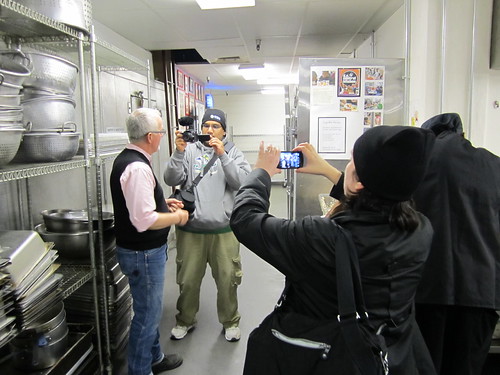
This year’s Day of Service featured three different projects – a computer recycling project and installation of a wireless network in Washington, DC’s largest homeless shelter and meal preparation at DC Central Kitchen. Approximately 100 volunteers participated in service activities. Event 360 was a sponsor for the Day of Service.
My role was to document the event and collect stories. I was lucky enough to work along side Mark Horvath and Shawn Ahmed, both experts at capturing stories on video and sharing through social channels. This post is a roundup of the videos, photos, and tweets from the day.
Tech Recycling Day
This volunteer service opportunity was intended to provide the homeless with job opportunities and an income through electronics recycling. Nonprofit techies helped collect, sort, and assess technology equipment for refurbishment and recycling at the WildTech Shelter.
The first shift of volunteers arrived on site at 7:00 am and we were given an orientation and an overview about how computer refurbishing can be an economic empowerment tool for the homeless and save the environment. The good folks at Event360 kept us warm and powered with coffee!
While volunteers were sorting donated computers and electronics, Shawn Ahmed [@uncultured] interviewed homeless advocate Eric Sheptock [@ericsheptock] about his activism for homelessness in DC.
Meal Preparation at DC Central Kitchen

Later in the morning, we were joined by another group of Day of Service volunteers who headed straight to the DC Central Kitchen — located in the same building as the WildTech Shelter — to serve as volunteer meal preparers.
While this may not be tech-focused, it’s still a great way to give back to the DC community. Robert Egger, founder, greeted us and gave the group an orientation.
On the wall, was something that Robert Egger referred to as “Codified Transparency” a bill of volunteer rights. In the video below, he explains the concept of how they want every volunteer to understand their impact and give them feedback in person and on the social web. To be a little meta, here’s a photo by Mark Horvath as the video was being shot.
Wireless Network Installation
A group of volunteers, with parts and guidance from Cisco, installed of a wireless network at the WildTech Shelter. This network will enable residents to access the Internet for job searches, ID requests, and everyday communications.
The Art of Story Capture
I focused on shadowing Mark and Shawn and asked them questions about their practice of story capture. Mark and Shawn have different approaches and philosophies, but the interviews yielded some insights about best practices.
Here’s a few points:
1.) Be prepared. Make sure you have caffeine and your devices or charged. If you don’t, you risk falling asleep or your camera will.
2.) Mark captures the story in a linear way and views it as a time line. He may grab stills, but will do a video to capture an interesting sound byte to explain different points in the time line.

3.) Mark uses an “extended arm” a mono pod that allows you and your interview subject to be in the shot without having a camera person. Since Mark works solo, this is a useful tool. Here’s an example.

4.) Shawn’s strategy is to find an interesting person and then capture their story. He will interview them for five minutes or longer, knowing that they will ramble. He later edits for the nuggets of gold. This requires editing which can be time consuming. This is in contrast to Mark who likes to capture the nuggets without editing and post quickly.
5.) Both Mark and Shawn tweet as they capture. Mark calls this “reality tweeting” and writes his tweets in a style that engages his audience and leaves them wondering what will come next.
6.) Mark likes using the FLIP camera because it is easy and it models that you don’t need an expensive camera to do this work. There’s a trade off because it has a built in mic.
7.) Both Mark and Shawn try to capture enough video without getting overwhelmed, although that it is difficult to avoid. Shawn knows when he is finished when he is filming for filming sake, rather than to tell a story. Both agree that a little bit of redundancy is good in case you mess up.
I’ve been participating in the Day of Service since 2001 and this one was the best ever.
Complete documentation can be found on the Day of Service wiki and post from Dan Michel at Feeding America.
Beth Kanter is a consultant, author, influencer. virtual trainer & nonprofit innovator in digital transformation & workplace wellbeing.

Leave a Reply